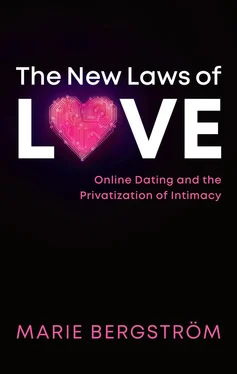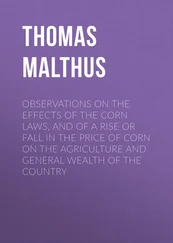Such an aim requires attention to both historical change and continuity. Whenever a new phenomenon is examined, there is a danger of referring to a past that is mostly mythical, in other words of depicting a time when love was blind, pure, and authentic, far removed from our contemporary experiences. Criticisms of online dating often stem from nostalgia for a past that never existed, fueled by fears of technological change, sexual transformations, and the ever-tightening grip of economic forces.
In steering a course between the fears of some and the enthusiasm of others, the book sets out to tell another story. It relies on a vast empirical investigation and comes to very different conclusions about what online platforms do to intimacy. The major change lies in a privatization of dating . As I will show throughout the book, this feature is fundamental for understanding the popularity of dating platforms, the way people use these sites and apps, and the type of relationships that stem from them. The book shows how dating has become a private matter, and reveals the implications of this shift for both intimate and social life. In doing so, it focuses on the heterosexual population. Rather than offering a general overview, which inevitably does injustice to LGBT experiences, it puts the majority group under the spotlight in order to better understand its specificity.
The privatization of dating
There is something dazzling and almost blinding about online dating. By focusing on the most spectacular features of the phenomenon, such as the mass of registered users, ostentatious self-presentations, and profile swiping, one may fail to detect another, seemingly minor characteristic, which is no less important: the social insularity of dating platforms. Online dating is detached from other social activities; it occurs outside an individual’s ordinary social circles and possibly without their knowledge.
This is surely the most important difference from earlier ways of meeting potential partners. Historically, heterosexual courtship has always been intimately tied to ordinary social settings, for example the neighborhood, the workplace, the church, the school, community activities, and leisure (Bozon and Heran, 1989; Laumann et al., 1994). This means that meeting venues have very much corresponded to the geography of social life. In the nineteenth century, young people in the countryside often met and courted in the fields; a hundred years later, they tended to meet at school or university. Of course, some settings have always been more propitious for seeking and meeting a spouse than others. Today’s bars, for instance, are certainly more conducive in this regard than supermarkets. But, with the notable exception of prostitution and swinging, there has never been a place allotted specifically and exclusively to heterosexual courtship. This is all the more the case as, at least from the nineteenth century on, finding love in the course of one’s everyday life has been an integral part of the romantic script: the initial encounter is expected to be a matter of fate, not something you seek out actively (Corbin, 1994; Bergström, 2013).
Today’s platforms, explicitly and wholly dedicated to dating, mark a radical break from this historical pattern. Meeting partners is now a specific social practice, with its own platforms, clearly delineated in space and time, and with an explicit purpose. The real novelty lies here, in the disembedding of dating from other social spheres and in its resulting privatization.
To feed and to clothe ourselves, to clean our homes, to nurse our kids and take care of our elderly parents… Over the past decades, we have become accustomed to resorting to private companies for the most intimate activities. When it comes to meeting partners, however, the idea of commercial intermediation was met with aversion for a long time. The dissemination of dating platforms from the 1990s onward corresponds to a progressive “disembedding” of dating. I borrow the term from Karl Polanyi (1944): it refers to a process whereby a series of activities that have previously been embedded in ordinary social relations become detached from society and form an autonomous market sphere.
This extension of capitalism, through the transformation of objects and activities into new products and services, has accelerated remarkably with the new technology. Critics of commodification are correct to point out the growing interconnections between the economy and intimacy. The diversification of technology and the intensification of its uses, which have penetrated so many areas of daily life, have opened up new areas for investment, and private companies are more present than ever in our private lives. Tech entrepreneurs now serve as intermediaries for our social interactions, including the most private ones, for instance communicating with friends and family, sharing photos, coordinating shopping lists and wedding lists, and getting to know people, make new friends, and meet partners and lovers. At the same time, the symbolic boundaries between what is “marketable” and what is “non-marketable” are constantly shifting and spur controversy. As the sociologist Viviana Zelizer observed, economic activity and intimate relations are often thought of as “separate spheres and hostile worlds” with radically different logics, involving rationality on the one hand and emotion on the other, “with inevitable contamination and disorder resulting when the two spheres come into contact with each other” (Zelizer, 2005, pp. 20–21). The expansion of the market into the private sphere has aroused strong fears and is accused of corrupting and “inexorably erod[ing] intimate social ties” (p. 25). The reactions to online dating provide a striking example of these tensions caused by the incursion of private actors into the sphere of intimacy.
Before jumping to the conclusion that intimate relations have somehow been taken over by commodification and rationalization, a key distinction must be made between online dating as an industry – which involves private companies trying to sell their services – and online dating as a practice – that is, how the platforms are used. The market mechanisms ruling the industry do not necessarily and automatically carry over into user practices. Conflating the two would on the one hand lead to a mechanical and deterministic reading of social behavior and, on the other hand, fail to recognize the autonomy of the market. To avoid these pitfalls, I have devoted a specific analysis to the economy of online dating. Despite growing concerns over the role of capitalist market forces in our private lives, there has been surprisingly little academic interest in the companies that operate in the sphere of privacy. This is the case with online dating, where the “market” metaphor, used to describe romantic and sexual interactions, has drawn attention away from the actual marketplace – the actors who create these products, their work, and the norms governing their business (Wilken et al., 2019; Pidoux et al., 2021). The first aim of the book is therefore to pry open the black box of the online dating industry.
The main goal is, nonetheless, to investigate the consequences for users. The disembedding of dating means bypassing ordinary social relations in the search for a partner. With digital platforms, dating becomes a private matter.
The transformation of social life
From its earliest days, the internet has raised questions about social ties. Theories and inquiries have differed over time, going often from enthusiasm to severe criticism, as we can see in the work of internet specialist Sherry Turkle. Known to many for her pioneering work on digital communities and identities, Turkle described the internet, in her first books, as a horizontal and fundamentally democratic universe, reflecting an era when computer users were a socially homogeneous and tech-savvy group and when the enthusiasm about networking was huge (Turkle, 1995). Her last books strike a very different tone. In Alone Together , the internet is no longer liberating but alienating. Turkle raises the alarm on how social media negatively affect our possibility to create real, authentic, and meaningful relationships, especially among young adults, leaving us constantly connected but more alone than ever (Turkle, 2011).
Читать дальше












